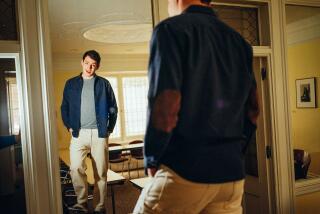Klezmatics Spice, Dice Their Jewish Musical Roots
- Share via
The Klezmatics is a band with a unique mission. Yes, it’s important for the New York City-based group to disseminate and carefully nurture the tradition of East European Jewish music known as klezmer. But it’s also important to tinker with the musical gene pool, to have an eclectic outlook, and to have fun in the process. The band name--think of a Veg-O-Matic--is a tip-off to the band’s dogma.
The Klezmatics made their first Los Angeles appearance last summer, in a program at the Ford Amphitheatre, in conjunction with the Naomi Goldberg Modern Dance and Ballet Company. But when they show up for two concerts as part of the summer series at the Brandeis-Bardin Institute this weekend, it will be, for most intents and purposes, the bona fide Southern California debut. They’ll return to perform at the new Ash Grove club in Los Angeles as part of a fall tour.
Lead vocalist and accordionist Loren Sklamberg said of their westward expansion, “Considering that I’m from L.A., I guess it’s about time.” Going west comes as a natural byproduct of a decade-long evolution, which has found them increasingly visible--and far beyond normal klezmer circles. Recently, they’ve been working with the klezmer-intrigued classical virtuoso Itzhak Perlman, and they were featured with Perlman on the PBS documentary “In the Fiddler’s House.”
This summer, they engaged in a bold cross-cultural experiment, working with the Master Musicians of Joujouka, the legendary and hypnotic performers from Morocco, for the Central Park Summer Stage concert series. “I wish I could say that it was the most overwhelming, cathartic experience of my life,” said Sklamberg of the project, “but I could say that it might have been the start of something interesting.”
Last year, the band released its third album, “Jews With Horns,” on the mostly world-music-oriented Xenophile label, and it’s a fine introduction to the group’s eclectic sound. The music is funky and funny, intricate and folksy, historically entrenched and up-to-date, all at once.
Is there an identifiable artistic agenda that the Klezmatics try to carry out? “We try to be true to ourselves and true to the history of the music,” ventured Sklamberg. “What that means is that we’re continuing the tradition of klezmer music and of Yiddish song. We participate in the process of the music changing and developing, as any type of music does over time.”
Though it is now a serious and dedicated endeavor, the Klezmatics formed in 1986 on a somewhat casual basis, a means of supplemental income for several New York players who were also interested in delving into the music.
“Personally,” Sklamberg said, “I found my own singing voice through playing with the band and doing this music. I’m particularly grateful for the experience. I’d been singing, but I hadn’t done much in the way of Yiddish music. Like most suburban Jews, I grew up with a lot of exposure to Israeli culture and Israeli music. That was basically all that was available to me.”
*
The deeper the players plunged into the roots and possible extensions of klezmer, the more intensive the work became. Simultaneously a new audience was congealing, a wide-eared market between jazz, world music, folk and rock crowds--in addition to the strictly Jewish audience.
“It’s lucky for us that our history as a band coincided with the development of the CD and the world music explosion. Klezmer music has always been in a funny place. The revival started in the late ‘70s, and it didn’t really fit in anywhere.
“I was involved in the folk-dance scene in L.A., mostly Balkan dance and music. Although most of the people playing that music were Jewish, they didn’t see fit to include [klezmer]. Now, suddenly, we’re validated, although not always by Jewish people.
“Thank you, Alex Haley, for opening people’s eyes about looking to their own past, their roots and their future. It was lucky for us.”
Collectively and individually, the Klezmatics have found themselves in creative collaborations with members of the so-called “downtown scene” in New York City, which has often revolved around that new-music haven the Knitting Factory. Marc Ribot, John Zorn and Elliott Sharp are among the downtowners who have interacted with the group and its members.
In the process of nudging definitions and creating new twists on the genre, the Klezmatics flirt with irreverence and brave controversy. More conservative klezmer listeners may take exception to the band’s liberties.
“I can’t decide if it’s better to be famous or infamous,” Sklamberg noted. “I think I prefer infamous. Sometimes the hardest audience to play to is the one which comes with a preconception of how the music should sound and what they’re going to hear. We take a lot of pleasure in opening peoples’ ears up.”
Sklamberg believes that by now there should be a peaceful coexistence among the many varieties of klezmer.
“It’s nice that there is diversity in this little klezmer world. There is the Klezmer Conservatory Band and Brave Old World and the Klezmatics. There are all these bands with different slants on the music, whether one band is preserving a particular period in klezmer music or there are bands who are more contemporary in their outlook. And I’m glad that we’re one of the latter ones.”
DETAILS
* WHAT: The Klezmatics.
* WHERE: Brandeis-Bardin Institute, 1101 Peppertree Lane, Simi Valley.
* WHEN: 8 p.m. Saturday, 7:30 p.m. Sunday.
* HOW MUCH: $20.
* CALL: 582-4455 or 582-4450.
More to Read
The biggest entertainment stories
Get our big stories about Hollywood, film, television, music, arts, culture and more right in your inbox as soon as they publish.
You may occasionally receive promotional content from the Los Angeles Times.










